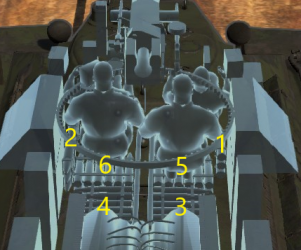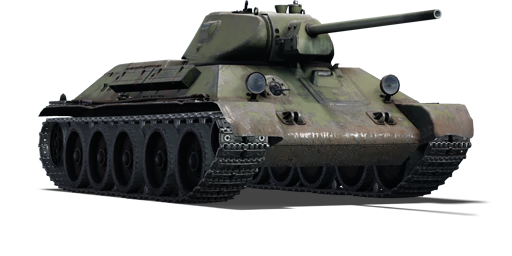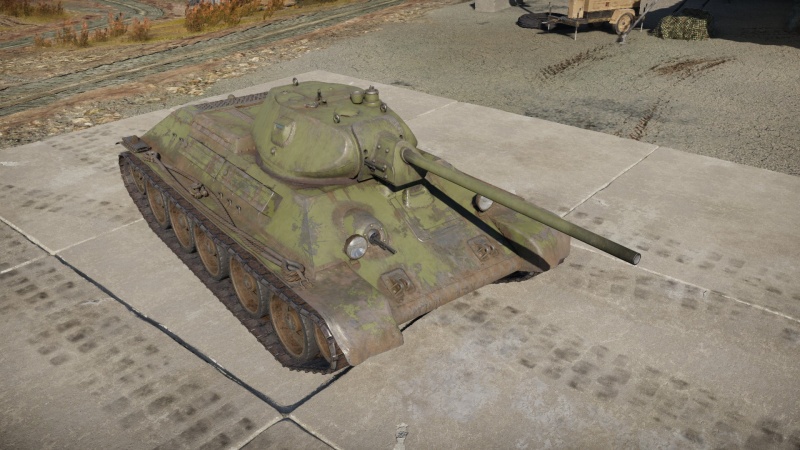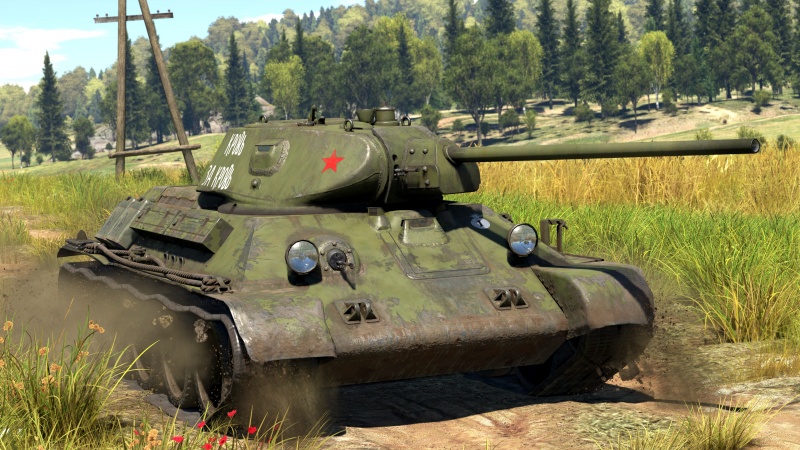T-34-57
| This page is about the Soviet medium tank T-34-57. For other versions, see T-34 (Family). |
Contents
Description
The T-34-57 (nickname: exterminator) was a fourth and experimental variant of the T-34 medium tank family. The Soviet Army was looking for new and upgraded guns to be mounted on its latest tanks as early as 1940. On May 19, 1941, testing of the new 57 mm ZIS-4 anti-tank gun began. V.G. Grabin designed this gun, which was based on the 57 mm ZIS-2 (2.25 in) gun. It was capable of firing a 3.14 kg warhead and could pierce 70 mm (2.76 in) of armour at a 30-degree angle at a range of 1000 m (1100 yd). The modified gun was fitted and tested in a T-34 (1941). Except for a longer barrel and a flat gun mantlet, it was nearly identical to a typical production T-34 (1941) variant. Despite some testing issues, the T-34-57 was approved for production in July 1941. Production of this T-34-57 variant began quickly but terminated in September after only 10 units were produced. The production run was cancelled due to a variety of problems, including insufficient manufacturing resources and a lack of armour-piercing ammunition for the 57 mm (2.25 in) ZiS-4. Most importantly, the RKKA did not want to disturb ongoing T-34 production variants. After all, the USSR had lost 20,000 tanks between June and September 1941. For the first and only time, the number of Soviet tanks went below that of the German tanks in October 1941. These tanks were referred to as "T-34 with ZIS-4" in Soviet records. However, after World War II, these tanks were renamed "Exterminator".
Introduced in the Closed Beta Test for Ground Forces before Update 1.41, the T-34-57 offers unrivalled armour penetration capability compared to other early variants of the T-34 medium tank family (1940, 1941, 1942, E STZ, E). Long-distance engagements are a strength of the T-34-57, comparable to German late variants of the Panzer IV medium tank family (F2, G, H, J). The T-34-57, however, lacks the powerful post-damage of other tanks due to the smaller calibre of the 57 mm ZIS-4 anti-tank gun. To completely destroy an opponent tank, players may need to fire many shots. Since the turret and hull chassis were identical, the T-34-57 has a comparable layout to the T-34 (1941) variant. Players who have already played earlier variants of the T-34 should have minimal challenge adjusting to this tank. Due to the similarities, the tank will undoubtedly inherit both the strengths and shortcomings of its ancestors. It should be remembered that armour is ineffective against most enemies of its ranks; therefore, using speed and agility to move rapidly, dodge enemy fire, and relocate from cover to cover will be helpful.
General info
Survivability and armour
Armour type:
- Rolled homogeneous armour
- Cast homogeneous armour (Turret, Driver's hatch, Machine gun port)
| Armour | Front | Sides | Rear | Roof |
|---|---|---|---|---|
| Hull | 45 mm (60°) Front glacis 45 mm (53°) Lower glacis 100 mm (0-38°) Joint plate 45 mm (61°) Driver's hatch 45 mm (0-32°) Machine gun port |
40 mm (40°) Top 45 mm Bottom |
40 mm (47-49°) Top 40 mm (46°) Bottom |
16 mm |
| Turret | 45 mm (3-67°) Turret front 45 mm (2-58°) Gun mantlet |
45 mm (28-35°) | 45 mm (30-31°) | 15 mm |
Notes:
- Suspensions wheels and tracks are 20 mm thick.
Mobility
| Game Mode | Max Speed (km/h) | Weight (tons) | Engine power (horsepower) | Power-to-weight ratio (hp/ton) | |||
|---|---|---|---|---|---|---|---|
| Forward | Reverse | Stock | Upgraded | Stock | Upgraded | ||
| Arcade | 55 | 8 | 28.3 | 775 | 954 | 27.39 | 33.71 |
| Realistic | 49 | 7 | 442 | 500 | 15.62 | 17.67 | |
Modifications and economy
Armaments
Main armament
| 57 mm ZIS-4 | Turret rotation speed (°/s) | Reloading rate (seconds) | |||||||||||
|---|---|---|---|---|---|---|---|---|---|---|---|---|---|
| Mode | Capacity | Vertical | Horizontal | Stabilizer | Stock | Upgraded | Full | Expert | Aced | Stock | Full | Expert | Aced |
| Arcade | 77 | -5°/+28° | ±180° | N/A | 23.8 | 32.9 | 40.0 | 44.2 | 47.1 | 6.50 | 5.75 | 5.30 | 5.00 |
| Realistic | 14.9 | 17.5 | 21.3 | 23.5 | 25.0 | ||||||||
Ammunition
| Penetration statistics | |||||||
|---|---|---|---|---|---|---|---|
| Ammunition | Type of warhead |
Penetration @ 0° Angle of Attack (mm) | |||||
| 10 m | 100 m | 500 m | 1,000 m | 1,500 m | 2,000 m | ||
| BR-271 | APHEBC | 145 | 142 | 128 | 112 | 98 | 86 |
| BR-271K | APHE | 145 | 140 | 118 | 95 | 77 | 63 |
| O-271 | HE | 12 | 12 | 10 | 8 | 6 | 5 |
| Shell details | ||||||||||||
|---|---|---|---|---|---|---|---|---|---|---|---|---|
| Ammunition | Type of warhead |
Velocity (m/s) |
Projectile mass (kg) |
Fuse delay (m) |
Fuse sensitivity (mm) |
Explosive mass (TNT equivalent) (g) |
Ricochet | |||||
| 0% | 50% | 100% | ||||||||||
| BR-271 | APHEBC | 990 | 3.14 | 1.2 | 9 | 21.56 | 48° | 63° | 71° | |||
| BR-271K | APHE | 990 | 3.14 | 1.2 | 9 | 27.72 | 47° | 60° | 65° | |||
| O-271 | HE | 700 | 3.72 | 0.4 | 0.1 | 220 | 79° | 80° | 81° | |||
Ammo racks

| Full ammo |
1st rack empty |
2nd rack empty |
3rd rack empty |
4th rack empty |
5th rack empty |
6th rack empty |
Visual discrepancy |
|---|---|---|---|---|---|---|---|
| 77 | 75 (+2) | 69 (+8) | 53 (+24) | 37 (+40) | 19 (+58) | 1 (+76) | No |
Note:
- Floor racks only: 69 (+8) shells.
Machine guns
| 7.62 mm DT | ||||
|---|---|---|---|---|
| Mount | Capacity (Belt) | Fire rate | Vertical | Horizontal |
| Coaxial | 1,890 (63) | 600 | N/A | N/A |
Usage in battles
The T-34-57 can be played in a variety of roles. The gun is very accurate and has high penetration, making it a great sniper. The tank is fast and manoeuvrable, making it a good flanker. It can also brawl due to its fast turret rotation and great reload speed. However, don't expect to take many hits. At this rank, the T-34's armour will not stand up to enemy guns, even when angled. The best thing to do is keep to the flanks or just behind the battle line and take out enemy tanks at the range and from cover.
In lower tier battles, the T-34 will be in its element, picking off common foes like Pz.IVs and Shermans with ease at long range. However, it is just as effective pushing towards capture points. At these ranks, the armour is still quite effective, so angling can make it very difficult to penetrate. Just be aware that the turret armour is not very strong.
At higher BRs, the tank will be less effective. There are many tanks that the gun will not be able to penetrate from the front. The Sherman Jumbo and Churchill VII are notable opponents. Their armour is very thick at the front, bar some small weak spots (machine gun ports). Luckily, you will be working with tanks like the T-34-85, SU-85 and even the IS-1, which can destroy the Jumbo under 500 m. Leave the front-line combat to them, flank and hit the enemies from the side. It is the only way for this tank to be fully effective. At higher BRs, the gun will have gone from being a highly effective precision weapon to a relatively hit-and-miss weapon. Some targets can be penetrated, others you will need to retreat from.
Pretty much any tank can be penetrated by the 57 mm gun at the T-34-57's BR, but there are a few enemies worth noting.
M4A3E2 Jumbo - This tank is the bane of everybody's life at this BR. Its turret in almost impossible to penetrate without APCR (which the T-34-57 does not have), its hull is VERY bouncy, and its gun can easily penetrate the T-34-57's armour. Avoid approaching from the front and flank with the T-34s superior mobility and speed if possible. Shoot at the forward section of the Jumbo's sides to ammo rack it. If backed into a corner, try to aim for the machine gun port in the hull. The explosive power of the 57 mm isn't great, but penetrating this point means that to at least cripple the Jumbo and make your escape.
Panzer IV variants armed with the 75 mm KwK40 L43 or L48 guns - These tanks are common enemies, and they can easily take the T-34-57 out with their powerful 75 mm guns. Nonetheless, they are relatively straightforward to remove if one has a head start on them. The high penetration 57 mm gun can slice through their armour at any range.
8,8 cm Flak 37 Sfl. - The flak truck can destroy your tank at seriously long range, whilst its thin armour and large size makes it very hard to effectively damage, rounds may simply pass straight through and not cause any damage. The best way to take one out is by aiming for the large ammo box at the back of the vehicle, which will explode when hit. The crew members are also very exposed on this vehicle.
Other T-34 tanks (except the 1940 variant) - Many of the T-34 variants (1941, 1942, T-34E STZ, etc.), including the T-34-57, can comfortably penetrate each other's armour at reasonable distances. When playing AB, it is likely to come up against other T-34 variants. Since you play this tank, it's easier to know its strengths and weaknesses. Make sure the hostile T-34 is not looking your way, then fire into the main hull or the turret to knock out the crew or blow up an ammo rack. Retreat to a safe distance before re-engaging. If confrontation is inevitable, angle the hull and fire into the front of the enemy to at least disable them and gain time to reposition, finish destroying the enemy, or escape.
Pros and cons
Pros:
- The gun has good penetration and rate of fire
- Very accurate gun with almost no recoil, and fast reload rate, making it easy for follow-up shots
- It's fast and nimble, like all the T-34 tanks
- The turret offers a smaller silhouette than the one mounted on the T-34 (1942)
- Its high penetration APHE ammunition is effective against all Rank II-III heavy tanks at close range
- Shells travel at an astounding 990 m/s, this combined with good accuracy makes sniping a viable option
- Although it is thin, the armour is sloped and can cause some lucky ricochets
Cons:
- The weak spot on the driver's hatch is problematic
- Still uses the 1940 hull, and the armour is inadequate for its rank
- Guns at this rank can easily get through the front plate
- Turret cheeks are easily penetrated, causing turret crew and gun to be knocked out
- The 57 mm gun rarely knocks out enemies in a single shot
- Can face tanks which the main gun will really start to struggle with, such as the M4A3E2 Jumbo
- Awkward to place bushes on upper front hull due to the obstruction of MG port and driver's optics
- Poor gun depression of only -5 degrees makes it ineffective in hilly and mountainous terrain
History
Development
As far back as the summer of 1940, an attempt to improve the anti-tank gun inventory in Soviet service was undertaken. This was due to only having massive stocks of underpowered 45 mm anti-tank cannons available, which were becoming obsolete with the newer armour being used by the Soviet Union's adversaries. When the request for an improved anti-tank cannon was sent out, a design bureau headed by V. G. Grabin was already underway under the name 57 mm ZiS-2 anti-tank gun. The 57 mm was a very powerful anti-tank weapon due to its high penetration value with the high-velocity shells. The APCBC round available under the name BR-271 was able to penetrate 93 mm of armour when fired 100 m away at a meet angle of 60 degrees. The first of the prototypes was created in September 1940, and it was later approved for production on June 1, 1941. However, this was stopped on December 1 due to the belief that the high-velocity 57 mm shells would simply penetrate straight through tanks without causing damage or that it was a high-cost weapon. The assembly lines were then switched to produce the 76.2 mm ZiS-3 guns.
Before being cancelled, the 57 mm gun was attached to a T-34 as a main armament in April 1941. However, the trials on this armament showed a lack of accuracy and short barrel life. Then in July, an improved variant of the 57 mm called the ZiS-4 was installed onto the T-34 and tested again. This variant turned out to be successful, and the gun was recommended for installation on certain T-34 units, despite the high cost of the ZiS-4. The T-34 with the 57 mm was redesignated the T-34-57 and had the purpose of being "tank-hunters" due to the higher penetration value of the 57 mm compared to the default T-34 76.2 mm armament. The 57 mm ZiS-4 gun was produced at the Artillery Factory #92 and was mounted on various T-34s. However, the stop of all 57 mm gun production, including the ZiS-4, in December 1941 also halted the T-34-57's, with only 133 ZiS-4 guns made.
Revitalization
The idea of using 57 mm guns was revived in 1943 due to urgent needs for much better guns against the newer German tanks. The current 76.2 mm F-34 gun on the normal T-34s were unable to defeat the newer German Tiger I and Panther tanks. In a desperate attempt to upgrade the T-34 to compete against these tanks, an improved version with simplified, standardised parts started to be produced and began being issued in May 1943, the models using it being named the T-34-57 mod. 1943 due to the upgraded armament. These T-34-57s saw further action against the Axis until they were retired. In total, about less than 324 T-34-57s were made during its production in 1941 and 1943.
Combat usage
The T-34-57s made in 1941 saw action in small quantities during the Battle of Moscow. 10 of these tanks were assigned to the 21st Tank Brigade and deployed on October 14. Though the brigade was able to cause massive damage to the German lines around Kalinin, by November 25 all the T-34-57s of the brigade were destroyed. Other units using the T-34-57 were the 8th Tank Brigade, used in battle on October 19. The 57 mm gun was removed from the assembly lines after 1941. However, the T-34-57s were reactivated in 1943 to counter the new German tanks. They were used as "tank-hunters" and formed the "Special Tank Company 100" with three T-34-57 in its first platoon to deal with German tanks. Despite their role, the company would only meet German tanks once in its existence, and the first platoon was never used. Thus, the T-34-57 was never really able to prove its efficiency against German tanks, though the unit would praise the gun's performance in practices against pillboxes, bunkers, and knocked out German tanks. All the T-34-57s were disbanded with the retirement of the 57 mm as a tank gun. This was due to its small HE shell available that made it an inadequate tank armament against softer targets, and also the introduction of the much bigger and better 85 mm tank gun on the newer T-34-85.
| Archive of the in-game description | |
|---|---|
|
Work on the tank began in the summer of 1940 with a view to upgrading its armament. At that time, the new 57 mm ZiS-2 anti-tank gun was put into operation. In April 1941, the weapon was installed on the tank and tested on a ballistic range. The tests were unsuccessful, and the cannon required significant modifications, which were performed on a tight schedule. In July of the same year, the improved weapon was installed on the tank again. This time, the results were much better: this version, named ZiS-4 and designed specifically for tanks, could destroy targets at a sighting distance of up to 2,000 m. At maximum distance, the weapon penetrated 73-82 mm thick armour, and at minimum distance, 83-98 mm thick armour. After these successful tests, the anti-tank gun was put into service under the designation ZiS-4 for the tank-mounted version. The tanks, designated T-34-57, were intended to go into production in the summer of 1941, but this deadline was pushed back by several months due to the beginning of the war. By the end of 1941, the No. 183 and STZ factories produced 42 of these tanks in total, 20 and 22 respectively. Production of the tanks was stopped due to the sufficient power of the F-34 cannon. The ZiS-2 and ZiS-4 cannons were taken out of production since their power was considered excessive for 1941. In summer-autumn, messages came from the front saying that the shell had penetrated straight through German tanks on multiple occasions, causing them no significant harm. T-34-57 tanks served in separate tank brigades. The tanks took part in the Battle of Moscow in the 21st Tank Brigade. On the whole, the vehicles performed well with the new cannon, but by 25 November 1941, all of them had been lost. | |
Media
- Skins
- Videos
See also
Links to the articles on the War Thunder Wiki that you think will be useful for the reader, for example:
- reference to the series of the vehicles;
- links to approximate analogues of other nations and research trees.
External links
| Kharkov Design Bureau for Mechanical Engineering named after A. A. Morozov | |
|---|---|
| Light Tanks | |
| BT-5 | BT-5 · RBT-5 |
| BT-7 | BT-7 · BT-7M · BT-7A (F-32) |
| Medium Tanks | |
| T-34-76 | T-34 (Prototype) · T-34 (1940) · T-34 (1941) · T-34 (1st Gv.T.Br.) · T-34 (1942) · T-34E STZ · T-34E |
| T-34-57 | T-34-57 · T-34-57 (1943) |
| T-34-85 | T-34-85 (D-5T) · T-34-85 · T-34-85E |
| T-34-100 | T-34-100 |
| T-44 | T-44 · T-44-100 · T-44-122 |
| Main Battle Tanks | |
| T-54 | T-54 (1947) · T-54 (1949) · T-54 (1951) |
| T-64 | T-64A (1971) · T-64B |
| Export/Captured | |
| T-34 | ▀T 34 747 (r) · ▄T-34 · ▄T-34-85 · ␗T-34 (1943) · ␗Т-34-85 (S-53) |
| T-54 | ▄T-54 |
| See Also | Uralmashzavod · Uralvagonzavod |
| USSR medium tanks | |
|---|---|
| T-28 | T-28 (1938) · T-28 · T-28E |
| T-34-76 | T-34 (Prototype) · T-34 (1940) · T-34 (1941) · T-34 (1st Gv.T.Br.) · T-34 (1942) · T-34E STZ · T-34E |
| T-34-57 | T-34-57 · T-34-57 (1943) |
| T-34-85 | T-34-85 (D-5T) · T-34-85 · T-34-85E |
| T-34-100 | T-34-100 |
| T-44 | T-44 · T-44-100 · T-44-122 |
| T-54 | T-54 (1947) · T-54 (1949) · T-54 (1951) |
| T-55 | TO-55 · T-55A · T-55AM-1 · T-55AMD-1 |
| T-62 | T-62 · T-62M-1 |
| T-64 | Object 435 · T-64A (1971) · T-64B |
| T-72 | T-72A · T-72AV (TURMS-T) · T-72B · T-72B (1989) · T-72B3 · T-72M2 Moderna |
| T-80 | T-80B · T-80U · T-80UD · T-80UK · T-80UM2 · Т-80U-Е1 · T-80BVM · Object 292 |
| T-90 | Т-90А · T-90M |
| Trophies/Lend-Lease | |
| Germany | ▂T-III · ▂T-V |
| Great Britain | ▂МК-IX "Valentine" |
| USA | ▂M3 Medium · ▂M4A2 |






